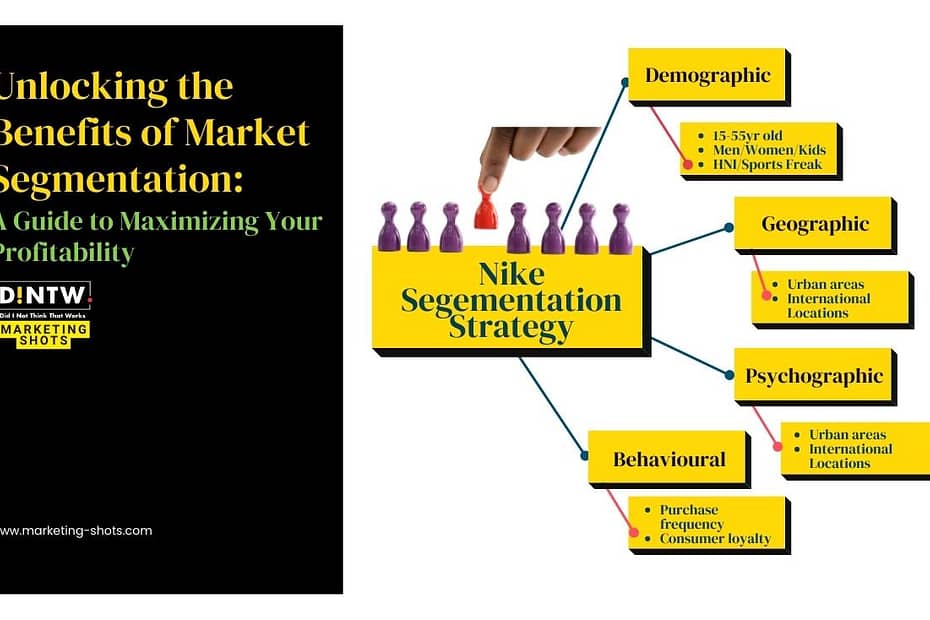Introduction
Let’s examine the significant benefits of market segmentation for your company if you’re trying to reduce customer acquisition expenses. You can more effectively comprehend the needs and desires of your customers by segmenting a market into smaller, more homogeneous groups. Use each market segment to create more effective product marketing initiatives and develop new products to increase customer satisfaction. And make better use of their resources and budgets by putting budgets and resources where they are needed most.
What is market segmentation?
Market segmentation 
How does Nike use market segmentation?
Nike uses behavioural segmentation to divide consumer needs: weekend runners, fashion shoppers, and devoted sneakerheads. It creates products using geospatial and demographic data to maintain product control for different customer segments. Subsequently, Nike does targeted marketing and offers customised experiences to appeal to this segment of users.

What are the benefits of market segmentation?
There are many benefits to market segmentation. Firstly, it helps you understand your customers better. You can identify your customers’ needs, preferences, and behaviours by segmenting them. This allows you to tailor your marketing messages and products to meet their needs more effectively.
Secondly, segmentation can help you reduce customer acquisition costs. You can focus your marketing spend on the most profitable segments by targeting the right segments. This can help you reduce your customer acquisition costs and increase your ROI.
Thirdly, segmentation can help you create more targeted marketing campaigns. By segmenting your customers, you can create tailored messages and offers that are more likely to convert. This can help you increase your conversion rate and maximize your ROI.
Finally, segmentation can help you increase customer loyalty. Understanding your customers’ needs can create more personalized experiences for them. This can help you build relationships with your customers and create loyalty.
What is Nike’s segmentation strategy?
Finite resources require laser-like concentration. Nike CEO Mike Parker demonstrated the importance of segmentation to Nike by realigning the corporate structure to six market segments that would generate the most growth for the company. Then, teams focused on customer insights relevant to the segments they controlled, driving segment-specific product offerings.
Women comprised one of the segments. This gender and psychographic segmentation created a new market for Nike, resulting in a 24% increase in revenue. In addition, Nike discovered that women spent 40% more than men on sports apparel and were willing to pay a premium for stylish apparel, particularly in aerobics and walking.
What are the different types of segments?
You can divide segments into two categories: current client groups and new prospects with whom you have never conducted business.
Existing Segments
As a first step in segmentation, the market should be divided into three types: discovery users, brand advocates, and potential explorers.
Discovery users are people who have never heard of your product or service before, and they represent a potential new customer base.
Brand advocates who promote a brand have likely purchased from that business before, so listening to their feedback and modelling their purchasing behaviour can boost the effectiveness of remarketing campaigns and strengthen customer loyalty over the long term.
Consumers who are open to trying a new brand or product within an established category are known as “potential explorers”. To reduce the overall customer acquisition cost, businesses can benefit from identifying these subsets in advance and allocating their resources accordingly.
New Segments
In addition to the above, there are four more market segments to target your customers: demographic, psychographic, geographic, and behavioural.
Demographic segmentation involves dividing your customers into groups based on their age, gender, income, education level, and other demographic factors. This type of segmentation is helpful if you want to target customers based on factors such as age, gender, income, and education. A brand, for example, could target young adults just starting their careers, middle-aged parents, or retirees.
Geographic segmentation involves dividing your customers based on their geographical location, region, or climate. A brand such as Nescafe will target people in northern India during the winter with cold coffee, those in southern India during the summer with cold coffee, and those in coastal areas with cold coffee during the day and hot coffee in the evening or at night.
Psychographic segmentation divides your customers into groups based on their interests, values, and lifestyles. Use it to gain insights into customers’ motivations, needs, and desires and create products that better meet unmet needs. A personal camera and the freedom to take pictures resulted in the development of the front-facing or “selfie” camera on mobile phones.
Behavioural segmentation involves dividing your customers based on their explicit or implicit interactions with your brand. A user visiting your website’s organic food section may also be interested in organic beverages. Similarly, for a B2B brand, a frequent visitor to the blog section on marketing automation could indicate that the user is seeking a marketing automation tool or service. Behaviorally, you can segment your traffic based on page visits, views, email opens, social media post engagement, webinar attendance, and offline event attendance.
Understanding customer needs
The first step in creating an effective market segmentation strategy is understanding your customers’ needs. You can conduct market research, such as surveys and focus groups. This will help you identify the needs and preferences of your target segments. In addition to market research, you should also analyze your existing customer data. This will help you identify patterns in your customers’ behaviour, such as their purchasing habits and what products or services they are most interested in.
Analyzing customer data
Once you have gathered and analyzed your customer data, you can create market segments. It would be best to look for patterns in the data, such as age, gender, income, location, and behaviour, to help you identify potential segments. This will help you understand what your customers need and want in a product or service.
Email marketing is an excellent tool for building customer relationships and driving sales. Therefore, what is the essential email marketing metric to track and understand? You want to know precisely what actions generate leads or sales as a brand. When Looking at Your Email Marketing Metrics 
Creating segmentation strategies
You can develop marketing strategies for each segment after developing your consumer groups. Each segment should have its unique messages and offers, which should be tailored to their needs and preferences. Your efforts should be concentrated on markets that are profitable and large enough to justify the CAC, ROI and profitability.
Create a Buyer Persona for each segment and map the purchasing process
After identifying the unique requirements of each customer segment, the next step is to determine how they will make a purchase. To achieve early success, target a large segment with a familiar user persona. Utilize customer surveys and interviews to ascertain their purchasing preferences and shopping patterns. Then, map out the customer touchpoints for each segment’s customer personas.
How does Nike map the purchase process for each consumer segment?
Think about the following examples from Nike: two types of customers the company has identified and the different lifestyle-focused products it makes for them.
In a few months, the “Weekend Runner,” a 30-year-old woman, will compete in a half marathon. As a frequent Nike Run Club app user, the company has a wealth of information regarding her running. Nike has also monitored her use of the company’s social media, websites, landing pages, and YouTube content. For her upcoming marathon, Nike will begin sending her celebrity endorsements of the latest running shoes.
The Nike app is designed for the “Style Shopper,” a 26-year-old male who desires to be fashionable before, during, and after workouts. The app also enables users to communicate directly with accomplished athletes for product recommendations and to schedule in-person meetings. Nike sends invitations to exclusive fashion shows and sponsors product demonstrations. It also sends personalised videos about new products in their colour and style to these users.
It is a fundamental shift in the buying journey that, if misunderstood, can reduce loyalty and revenues. This article will walk you through creating customer journey maps for email marketing campaigns 
Assessing segment performance
Once you have created your segmentation strategies, you should assess their performance. You should track each segment’s success and measure each segment’s ROI and CAC (customer acquisition costs). This will help you identify the most profitable segments and focus your efforts on those segments.
Understanding your customer acquisition costs (CAC) before you launch your marketing campaign is essential. This metric measures how much you’re spending to acquire a new customer.
There are a few different ways to calculate CAC, but here’s a basic formula:
CAC = “Cost of Goods Sold” (COGS) + “Marketing Costs.”
COGS includes the cost of the product or service you’re selling and shipping or handling costs. Marketing costs include advertising, PR, and sales expenses. You’ll want to keep your CAC as low as possible since it can eat your profits.
For example, if your CAC is $50 and your average sale value per customer is $10, you only make a $10 profit on each customer.
There are a few ways to reduce your CAC. One, you can also focus on reducing your COGS. You’ll attract more customers if you can offer a high-quality product or service at a low price. Whatever strategy you choose, tracking your CAC and ensuring it’s as low as possible is essential. By doing so, you’ll be able to increase your profits and grow your business.
Conclusion
In conclusion, market segmentation is an essential tool for any business that wishes to reduce customer acquisition costs and increase profits. By segmenting your customers, you can target them more effectively, increase customer loyalty, reduce customer acquisition costs, and improve your marketing ROI. At DINTW, we conduct digital audits and offer to consult services to help you create and implement a customer segmentation strategy. Using an omnichannel marketing strategy, we develop a customer buying journey for various customer segments. We also help our clients understand how their customers use their products and services by giving them data-driven insights.
The post Unlocking the Benefits of Market Segmentation: A Guide to Maximizing Your Profitability appeared first on DINTW Digital Marketing Shots.

